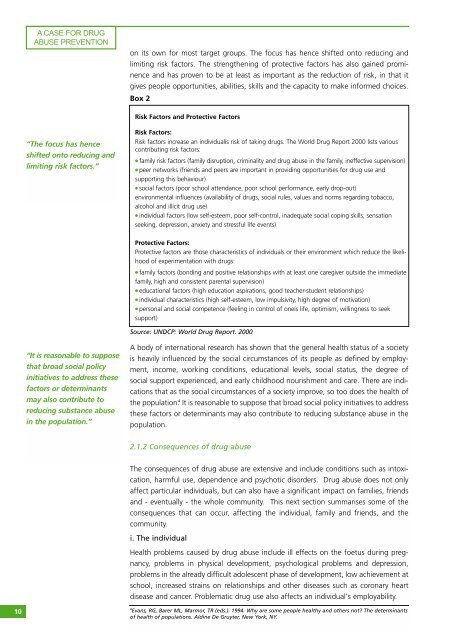PDF (Lessons learned in drug abuse prevention: a global review)
PDF (Lessons learned in drug abuse prevention: a global review)
PDF (Lessons learned in drug abuse prevention: a global review)
You also want an ePaper? Increase the reach of your titles
YUMPU automatically turns print PDFs into web optimized ePapers that Google loves.
A CASE FOR DRUG<br />
ABUSE PREVENTION<br />
on its own for most target groups. The focus has hence shifted onto reduc<strong>in</strong>g and<br />
limit<strong>in</strong>g risk factors. The strengthen<strong>in</strong>g of protective factors has also ga<strong>in</strong>ed prom<strong>in</strong>ence<br />
and has proven to be at least as important as the reduction of risk, <strong>in</strong> that it<br />
gives people opportunities, abilities, skills and the capacity to make <strong>in</strong>formed choices.<br />
Box 2<br />
Risk Factors and Protective Factors<br />
“The focus has hence<br />
shifted onto reduc<strong>in</strong>g and<br />
limit<strong>in</strong>g risk factors.”<br />
Risk Factors:<br />
Risk factors <strong>in</strong>crease an <strong>in</strong>dividualís risk of tak<strong>in</strong>g <strong>drug</strong>s. The World Drug Report 2000 lists various<br />
contribut<strong>in</strong>g risk factors:<br />
● family risk factors (family disruption, crim<strong>in</strong>ality and <strong>drug</strong> <strong>abuse</strong> <strong>in</strong> the family, <strong>in</strong>effective supervision)<br />
● peer networks (friends and peers are important <strong>in</strong> provid<strong>in</strong>g opportunities for <strong>drug</strong> use and<br />
support<strong>in</strong>g this behaviour)<br />
● social factors (poor school attendance, poor school performance, early drop-out)<br />
environmental <strong>in</strong>fluences (availability of <strong>drug</strong>s, social rules, values and norms regard<strong>in</strong>g tobacco,<br />
alcohol and illicit <strong>drug</strong> use)<br />
● <strong>in</strong>dividual factors (low self-esteem, poor self-control, <strong>in</strong>adequate social cop<strong>in</strong>g skills, sensation<br />
seek<strong>in</strong>g, depression, anxiety and stressful life events)<br />
Protective Factors:<br />
Protective factors are those characteristics of <strong>in</strong>dividuals or their environment which reduce the likelihood<br />
of experimentation with <strong>drug</strong>s:<br />
● family factors (bond<strong>in</strong>g and positive relationships with at least one caregiver outside the immediate<br />
family, high and consistent parental supervision)<br />
● educational factors (high education aspirations, good teacher-student relationships)<br />
● <strong>in</strong>dividual characteristics (high self-esteem, low impulsivity, high degree of motivation)<br />
● personal and social competence (feel<strong>in</strong>g <strong>in</strong> control of oneís life, optimism, will<strong>in</strong>gness to seek<br />
support)<br />
Source: UNDCP: World Drug Report. 2000<br />
“It is reasonable to suppose<br />
that broad social policy<br />
<strong>in</strong>itiatives to address these<br />
factors or determ<strong>in</strong>ants<br />
may also contribute to<br />
reduc<strong>in</strong>g substance <strong>abuse</strong><br />
<strong>in</strong> the population.”<br />
A body of <strong>in</strong>ternational research has shown that the general health status of a society<br />
is heavily <strong>in</strong>fluenced by the social circumstances of its people as def<strong>in</strong>ed by employment,<br />
<strong>in</strong>come, work<strong>in</strong>g conditions, educational levels, social status, the degree of<br />
social support experienced, and early childhood nourishment and care. There are <strong>in</strong>dications<br />
that as the social circumstances of a society improve, so too does the health of<br />
the population. 4 It is reasonable to suppose that broad social policy <strong>in</strong>itiatives to address<br />
these factors or determ<strong>in</strong>ants may also contribute to reduc<strong>in</strong>g substance <strong>abuse</strong> <strong>in</strong> the<br />
population.<br />
2.1.2 Consequences of <strong>drug</strong> <strong>abuse</strong><br />
The consequences of <strong>drug</strong> <strong>abuse</strong> are extensive and <strong>in</strong>clude conditions such as <strong>in</strong>toxication,<br />
harmful use, dependence and psychotic disorders. Drug <strong>abuse</strong> does not only<br />
affect particular <strong>in</strong>dividuals, but can also have a significant impact on families, friends<br />
and - eventually - the whole community. This next section summarises some of the<br />
consequences that can occur, affect<strong>in</strong>g the <strong>in</strong>dividual, family and friends, and the<br />
community.<br />
i. The <strong>in</strong>dividual<br />
Health problems caused by <strong>drug</strong> <strong>abuse</strong> <strong>in</strong>clude ill effects on the foetus dur<strong>in</strong>g pregnancy,<br />
problems <strong>in</strong> physical development, psychological problems and depression,<br />
problems <strong>in</strong> the already difficult adolescent phase of development, low achievement at<br />
school, <strong>in</strong>creased stra<strong>in</strong>s on relationships and other diseases such as coronary heart<br />
disease and cancer. Problematic <strong>drug</strong> use also affects an <strong>in</strong>dividual's employability.<br />
10<br />
4 Evans, RG, Barer ML, Marmor, TR (eds.). 1994. Why are some people healthy and others not? The determ<strong>in</strong>ants<br />
of health of populations. Ald<strong>in</strong>e De Gruyter, New York, NY.
















